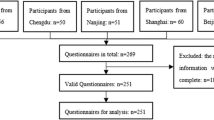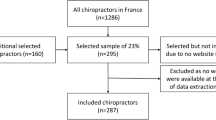Abstract
Background
Acupuncture and moxibustion, massage, bone-setting, manual therapy, and chiropractic treatments are representative components of orthopedic complementary and alternative medicine (OCAM) in Japan. However, the state of their utilization and characteristics are unclear, and have yet to be thoroughly surveyed. The objective of this study was to survey the utilization and characteristics of OCAM in the general public.
Materials and methods
In January 2011, we conducted a self-administered online questionnaire survey with 10,400 members of the general public, who were registered as consumer reviewers at the internet survey company. Survey topics were the use of OCAM within one month prior to the survey, the objective of using OCAM, and the presence or absence of consultation with and recommendation or referral by a physician. The subjects were divided into those who used and did not use OCAM as user and non-user groups, respectively, and the age, sex, and prevalence of past treatment for orthopedic diseases at medical institutions were compared between the groups. Data of 3,211 subjects (1,611 males and 1,600 females, mean age: 44.7 years old) were analyzed.
Results
Four hundred and thirty-eight subjects (13.6 %) used OCAM within one month prior to the survey. The subjects in their forties used OCAM most frequently, followed by those in their twenties. The most frequent objective of OCAM usage was treatment, accounting for 63 % (275 subjects) of the subjects. Fifty-three subjects (12.1 %) consulted a physician, and 48 (11 %) were recommended or referred by a physician. Upon logistic regression analysis, significant differences were detected in age, sex, and prevalence of treatment at a medical institution in the user group. A decreasing trend in the odds ratio correlated with subjects having received previous treatment at a medical institution, female subjects, and subjects of a younger age (p = 0.01; odds ratio = 4.33, 1.43, and 1.01, respectively), and these factors were independent.
Conclusion
It was determined that 13.6 % of the subjects had used OCAM, and many relatively young females (especially those in their forties or twenties) with a past medical history used it based on their own judgment.





Similar content being viewed by others
References
Yamashita H, Tsukayama H, Sugishita C. Popularity of complementary and alternative medicine in Japan: a telephone survey. Complement Ther Med. 2002;10(2):84–93.
Hikoyoshi J. Complementary and alternative medicine in orthopedics. J Ther. 2007;89(3):849–53 (in Japanese).
MacLennan AH, Wilson DH, Taylor AW. Prevalence and cost of alternative medicine in Australia. Lancet. 1996;347(g001):569–73.
Eisenberg DM, Davis RB, Ettner SL, Appel S, Wilkey S, Rompay M, Kessler R. Trends in alternative medicine use in the United States, 1990–1997: results of a follow-up national survey. J Am Med Assoc. 1998;280(18):1569–75.
Ernst E, White A. The BBC survey of complementary medicine use in the UK. Complement Ther Med. 2000;8(1):32–6.
Horikawa H, Akamatsu R, Horiguchi I, Marui E. Respnse rates to a pstal questionnaire survey analyzing by occupation: the data among elementary school staff members about the food survey. Jpn J Nutr Diet. 2011;69(4):193–8 (in Japanese).
Kenyon S, Pike K, Jones D, Taylor D, Salt A, Marlow N, Brocklehurst P. The effect of a monetary incentive on return of a postal health and development questionnaire: a randamised trial [ISRCTN 53994660]. BMC Health Serv Res. 2005;18(5):55.
Lavelle K, Todd C, Cambell M. Do postage stamps versus pre-paid envelops increase responses to patient mail survey? A randomized controlled trial. BMC Health Serv Res. 2005;28(8):113.
Okuma Y, Miyazaki S, Yoshida N, Mukaino Y, Hisajima T, Takahashi H. Complementary and alternative medicine usage by intercollegiate athletes in Japan. J Clin Sport Med. 2012;20(2):351–9 (In Japanese).
Conflict of interest
None.
Author information
Authors and Affiliations
Corresponding author
About this article
Cite this article
Watanabe, H., Horiguchi, I., Hayasaka, S. et al. Determining the general utilization and characteristics of orthopedic complementary and alternative medicine using a self-administered online questionnaire in Japan. J Orthop Sci 20, 547–550 (2015). https://doi.org/10.1007/s00776-015-0708-6
Received:
Accepted:
Published:
Issue Date:
DOI: https://doi.org/10.1007/s00776-015-0708-6




